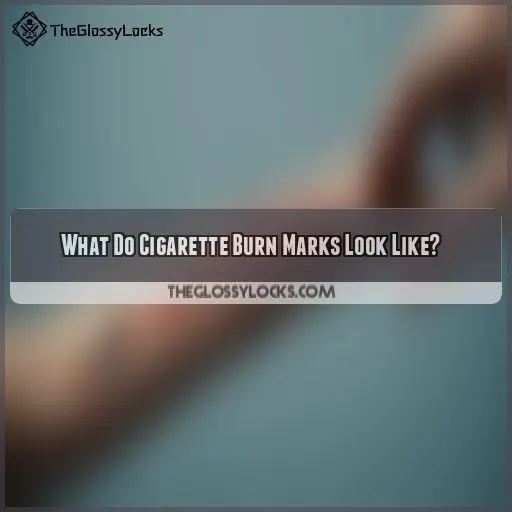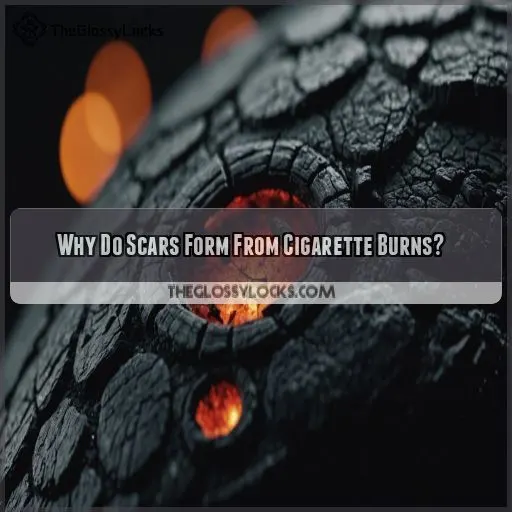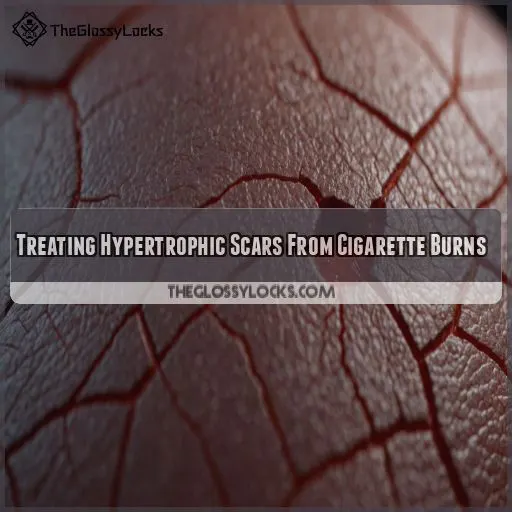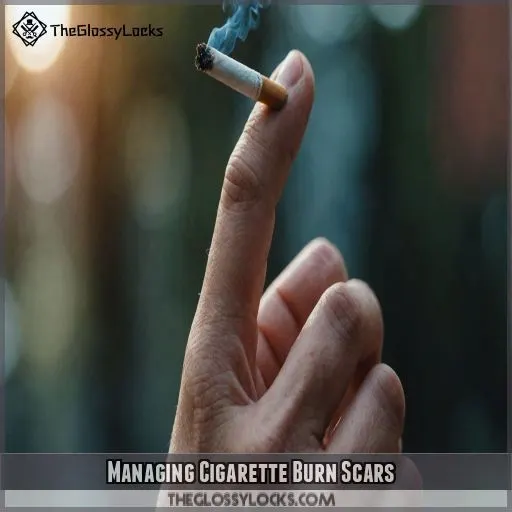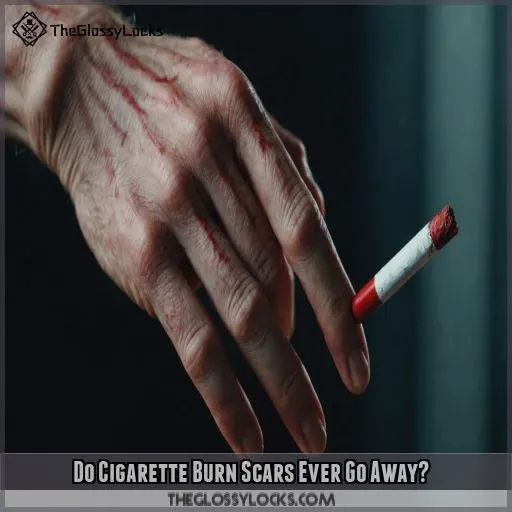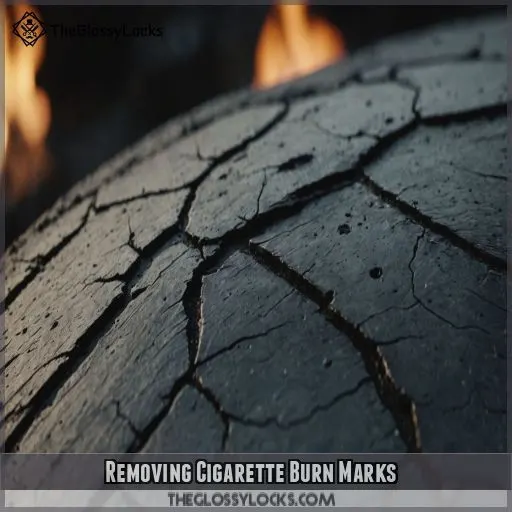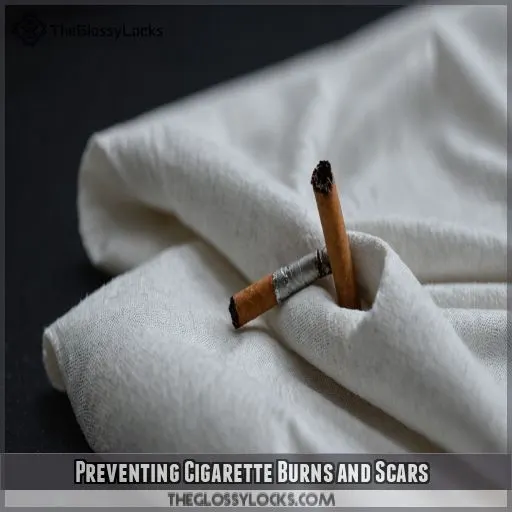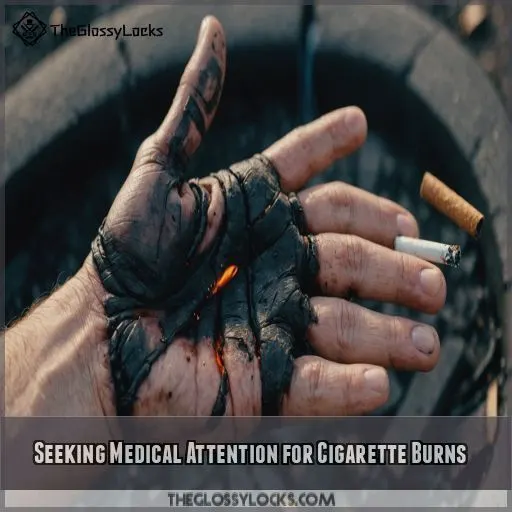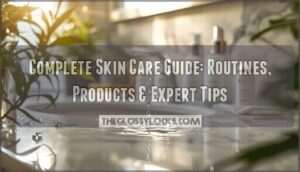This site is supported by our readers. We may earn a commission, at no cost to you, if you purchase through links.
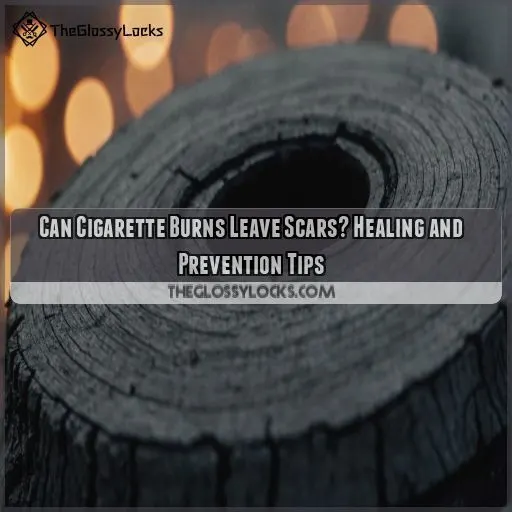 Yes, cigarette burns can leave scars.
Yes, cigarette burns can leave scars.
These scars may be permanent, especially if the burn is deep and penetrates multiple layers of skin.
The severity of the burn determines the likelihood and extent of scarring.
Cigarette burns can reach extremely high temperatures, causing wounds that go beyond the surface level.
As a result, the affected area may be slow to heal and prone to infection, often leaving noticeable marks.
To learn more about the appearance of these scars and how to manage them, read on.
Table Of Contents
- Key Takeaways
- Can Cigarette Burns Leave Scars?
- What Do Cigarette Burn Marks Look Like?
- Why Do Scars Form From Cigarette Burns?
- What Are Hypertrophic Burn Scars?
- Treating Hypertrophic Scars From Cigarette Burns
- Managing Cigarette Burn Scars
- Do Cigarette Burn Scars Ever Go Away?
- Removing Cigarette Burn Marks
- Preventing Cigarette Burns and Scars
- Seeking Medical Attention for Cigarette Burns
- Frequently Asked Questions (FAQs)
- Do cigarette burn scars go away?
- What does a cigarette burn mark look like?
- Do burns leave permanent scars?
- How to remove cigarette burn marks?
- Are there different types of burn scars?
- Whats the best way to prevent scarring?
- How long does it take for a burn to heal?
- What are the emotional effects of scarring?
- How can you tell if a burn is infected?
- Conclusion
Key Takeaways
- Cigarette burns reach insane temperatures of 900 °C (1,650 °F), causing deep wounds that often leave noticeable scars.
- These scars can be thick, red or purple patches that are sensitive, itchy, and prone to infection.
- The healing journey is a marathon, not a sprint – it can take up to 18 months for these scars to fully mature and fade.
- Quick action and proper treatment are key to preventing and minimizing scars, so don’t delay that trip to the doctor.
Can Cigarette Burns Leave Scars?

You’ve probably heard that cigarette burns can be dangerous, but do they actually leave scars? It’s time to find out.
Cigarette Burn Basics
Cigarette burns are no joke. They can reach scorching temperatures of nearly 900 °C (1,650 °F). That’s hot enough to do some serious damage to your skin.
- Burn Depth: Cigarette burns can vary in depth, from superficial burns that may heal without scarring to deeper burns that penetrate the lower layers of your skin and can cause permanent scars.
- Healing Time: Cigarette burn scars may take months to heal and mature fully.
- Scarring: While some burns may heal without a trace, deeper burns can leave behind scars that are slow to heal and prone to infection.
Now you know the basics, let’s move on to prevention and treatment.
Prevention and Treatment
If you’re dealing with a cigarette burn, your first instinct might be to reach for ice or an ointment to soothe the pain. But hold up! While your intentions are good, it’s important to know that these remedies can actually do more harm than good. So, what’s the right way to handle these burns and avoid scarring?
Here’s a simple table with some dos and don’ts to guide you:
| Do | Don’t |
|---|---|
| Run the burn under cool water | Use extremely cold water or ice |
| Apply aloe vera or vitamin E gel | Apply topical butters or ointments |
| Wrap the burn in non-stick gauze | Touch, scratch, or rub the burn |
What Do Cigarette Burn Marks Look Like?
If you’re wondering what cigarette burn marks look like, picture punched-out ulcerations with purple crusts and a dry base that doesn’t expand. These burns can involve multiple layers of skin, heal slowly, and often leave scars that may become infected.
Identifying Patterns of Abuse
Cigarette burn marks are a form of child abuse, and they can leave distinct patterns and scars. Here’s what to look out for:
- Punched-out ulcerations
- Purple crusts
- Multiple layer involvement
- Potential for secondary infection
These signs could indicate cigarette burn abuse, which has a higher mortality rate than accidental burns.
Distinguishing Cultural Practices From Abuse
Sometimes, burn marks are the result of cultural practices rather than abuse. Here’s how to tell the difference:
Cupping: This practice leaves circular burns from heat, along with central bruising and tiny red spots from suction.
Coining: You’ll see linear red marks, usually on the back, which may also have tiny red spots or purple discolouration.
Moxibustion: Look for small, circular burns around 5-10mm in diameter.
Educating parents about the risks and providing alternative treatments can help prevent accidental injury.
Why Do Scars Form From Cigarette Burns?
You’ve seen the ugly marks cigarette burns can leave, but why do they often scar? Scars form when the lower layer of your skin, the dermis, takes a hit. The body then steps in with collagen to repair the damage, but this can lead to raised, discolored scars that may cause self-consciousness and limit movement.
How Scars Form
Scars form when the lower layer of your skin, the dermis, is damaged. Your body produces collagen to repair the skin, but sometimes this process can lead to hypertrophic scars, which have a different texture and appearance due to disorganized collagen fibers. This type of scarring is common with cigarette burns and can result in itching and sensitivity.
- Cigarette burns damage the dermis.
- Collagen production is triggered to repair the skin.
- hypertrophic scars form with disorganized collagen fibers.
- Healing takes time, peaking around 6 months and maturing in 12-18 months.
- Scars can be sensitive, itchy, and impact your daily life.
Factors Influencing Scarring
A bunch of factors influence whether a cigarette burn will scar.
The depth of the burn, your skin type, age, and the location of the burn all play a part.
Even your ethnicity affects how likely you are to scar.
For example, people with darker skin tones are more prone to hypertrophic scars.
What Are Hypertrophic Burn Scars?
Okay, let’s get into the nitty-gritty of hypertrophic burn scars and how they’re different from other types of scars.
Hypertrophic scars are thick, raised scars that develop within the boundaries of the original burn wound. They typically appear within the first few months after a burn injury and can be quite noticeable.
Characteristics of Hypertrophic Scars
Hypertrophic scars are raised patches of skin that develop within the original burn area.
They typically form in the first few months after a burn injury.
These scars are often deep red to purple in color and raised above the surrounding skin.
They may be warm to the touch and sensitive to the slightest touch.
Hypertrophic scars are more noticeable around joints due to the natural movement and tension of the skin in these areas.
Common Problems With Hypertrophic Scars
Hypertrophic scars can have some unwanted side effects. Here are some common problems you might experience:
- Contractures: These can develop across joints, limiting your mobility and affecting your range of motion.
- Itching: Burns can damage oil glands, leading to dry skin and an itchy scar.
- Sun Sensitivity: Scars are more susceptible to sun damage and discolouration, so be extra cautious when exposing them to sunlight.
Treating Hypertrophic Scars From Cigarette Burns
If you’ve got a hypertrophic scar from a cigarette burn, there are ways to manage it. We’ll go over how to handle the itching and sensitivity that come with these scars, as well as how to protect your skin from sun exposure.
Contractures
Hypertrophic scars from cigarette burns can lead to contractures, limiting your joint mobility. Contractures occur when the scarred area becomes tight and restricts movement. To prevent and manage contractures, focus on these strategies:
| Prevention and Management Strategies | Recommendations |
|---|---|
| Scar Massage | Try scar massage to soften and flatten the scar tissue, improving joint flexibility. |
| Physical Therapy | Work with a physical therapist to develop a personalized plan for joint rehabilitation and stretching exercises. |
| Joint Mobility | Prioritize joint mobility exercises to maintain and improve your range of motion. |
The key to successful contracture prevention and management is early intervention, so don’t delay in seeking advice from healthcare professionals.
Itching
Cigarette burns can leave you with an itchy feeling that’s hard to ignore. The good news is, you’ve got options to calm that itch. First, reach for moisturizers with a high water content and apply them often. Second, medications like gabapentin, pregabalin, and antihistamines can provide relief. Don’t scratch or rub the area, as tempting as it may be.
Sun Exposure
Sun protection is a must. Discolored and unmatured scars are extra sensitive to UV rays, so avoid direct sunlight. Plan outdoor activities for early morning or late evening when the sun’s rays are less intense. When you’re out and about, cover up with clothing or slap on sunscreen with an SPF of 30 or higher. Reapply sunscreen regularly when you’re outdoors.
Managing Cigarette Burn Scars
So, you’ve got a cigarette burn scar. Now what? It’s time to focus on managing that scar and making sure it doesn’t cause any further issues. You’ll learn how to minimize its appearance and deal with any discomfort.
Moisturizing and Sun Protection
While your burn scar is healing, it’s important to keep it moisturized and protected from the sun. Here are some tips to help:
- Use a gentle and nourishing best moisturizing bar soaps that contain hydrating ingredients like shea butter and glycerin to help restore skin’s natural barrier, then use moisturizers with a high water content frequently to combat dry skin and itching.
- Avoid direct sun exposure on your scar, especially during peak hours.
- Opt for outdoor activities during the early morning or late evening when the sun is less intense.
- When you’re out and about, apply sunscreen with SPF 30 or higher, and reapply every couple of hours.
Medications for Itching
If you’re dealing with an itchy cigarette burn scar, there are a few medication options to try:
- Antihistamines: Block histamine, a chemical that amps up itching and inflammation.
- Gabapentin: Often used for nerve pain, this can also calm itching.
- Pregabalin: Similar to gabapentin, this medication takes down itching and nerve pain.
Do Cigarette Burn Scars Ever Go Away?
You might be wondering if those pesky cigarette burn scars will ever fade. Well, the answer is yes, but it takes time and patience.
Scar healing is a gradual process, and it can take up to 18 months for scars to fully mature and fade.
Timeline for Scar Maturation
Scars from cigarette burns can take a long time to mature and may never completely disappear. Here’s a general timeline of scar maturation:
- Scar formation: This occurs within the first few months after the injury.
- Scarring peaks: You’ll typically notice the most prominent scarring around six months after the burn.
- Scar maturation: It takes about 12–18 months for scars to fully mature and reach their final appearance.
- Long-term changes: Even after maturation, scars can continue to evolve with time.
While the appearance of scars may improve, it’s important to manage expectations. These marks are permanent reminders of the body’s healing process.
Factors Affecting Scar Appearance
Several factors influence how scars look, including your age, ethnicity, how deep the burn is, and where it’s located. Scars are more noticeable around joints because of the skin’s natural movement and tension. The deeper the burn, the more likely it’ll leave a permanent mark.
Removing Cigarette Burn Marks
Cigarette burns can leave unsightly marks on your skin, but there’s no need to panic. In this section, we’ll explore ways to remove these burn marks and restore your skin’s appearance.
Treatment Options
If you’re dealing with cigarette burn marks, there are a few ways to go about treatment.
One option is scar removal through procedures like laser therapy.
This can help reduce the appearance of scars and promote healing.
Another approach is scar massage, which can improve the texture and flexibility of the scar tissue.
Silicone sheeting and pressure therapy are also methods to try, as they can flatten and soften scars.
Professional Help
If you’re dealing with stubborn cigarette burn marks, it might be time to call in the pros. Here’s when to seek professional help:
- Scar treatment options — If home remedies aren’t cutting it, a doctor can recommend advanced treatments.
- Doctor consultation — They’ll assess the severity and give you advice that fits your situation.
- Laser therapy — This targets scar tissue with precision, helping to reduce scars and promote healing.
- Scar removal — In severe cases, surgical scar removal might be an option.
- Professional advice — Therapists offer guidance and support through the challenges of healing.
Preventing Cigarette Burns and Scars
Whether you’re a smoker or simply want to be prepared, knowing how to prevent cigarette burns and scars is a smart move. After all, no one wants to deal with the pain and hassle of healing a burn or the potential long-term impact of scarring.
Safety Precautions
To prevent cigarette burns and scars, follow these safety precautions:
- Practice fire safety and burn prevention.
- Be careful when handling cigarettes and lighters.
- Be prepared with first aid knowledge and supplies, including cool water, aloe vera, and gauze.
Avoiding Risky Behaviors
You don’t want to end up with scars from cigarette burns, so it’s important to avoid risky behaviors. This is especially important for teens, who may be more susceptible to peer pressure and experimentation with substances like cigarettes. Here are some tips to keep yourself and your loved ones safe:
- Teen smoking: If you’re a teen, don’t start smoking. It’s as simple as that. Smoking is a dangerous habit that can lead to serious health issues, including burns and scars.
- Safe environments: Avoid places where smoking is prevalent, like bars or parties, especially if you’re a minor.
- Parental guidance: Parents, keep an open dialogue with your teens about the dangers of smoking. Provide them with safe alternatives to hanging out in risky environments.
Stay vigilant!
Seeking Medical Attention for Cigarette Burns
While minor cigarette burns may not require a trip to the doctor, deeper burns or large wounds warrant medical attention. If you’re unsure about the severity of your burn, it’s always best to seek professional advice.
Burns That Need Medical Attention
If a burn is severe, seek medical attention immediately. Here are some signs that indicate a burn needs professional care:
- The burn is larger than your palm.
- It’s a deep burn, with white or charred skin.
- It’s an electrical or chemical burn.
- The burn is on your face, hands, feet, groin, buttocks, or a major joint.
- You’re experiencing severe pain, shock, or difficulty breathing.
- The burn is infected, with increasing redness, swelling, or discharge.
When to Get Further Medical Advice
If your burn is large, deep, or painful, or if it’s a child’s burn, get medical advice. Keep an eye out for signs of infection, like redness, swelling, or pus. If you’re worried about scarring or healing, a doctor can help.
Frequently Asked Questions (FAQs)
Do cigarette burn scars go away?
Yes, cigarette burns can leave scars. The healing process takes time, with scarring peaking around 6 months and maturing in 12–18 months.
What does a cigarette burn mark look like?
Cigarette burns are round, about 1 cm in diameter, with a pale centre and darker edges. They can look like punched-out ulcerations with purple crusts and a dry base.
Do burns leave permanent scars?
How long will that burn scar last?
It depends on the burn depth. Superficial burns may heal without scarring, but deeper burns often leave permanent scars. The good news is, proper treatment and care can help minimise scarring.
How to remove cigarette burn marks?
Removing cigarette burn marks from fabric can be done with laundry detergent or bleach. You can also use a small razor to cut the fabric, cover the burn with matching fabric, and glue it over.
Are there different types of burn scars?
Yes, there are different types of burn scars. For example, hypertrophic scars are raised, red or purple, and often develop near joints. These scars can be itchy and sensitive to the sun.
Whats the best way to prevent scarring?
Quick treatment and proper wound care are the best ways to prevent scarring. Reach out to a burn specialist for immediate treatment, including scar prevention. Aloe vera can also help repair and cool skin.
How long does it take for a burn to heal?
I can’t tell you exactly how long a burn will take to heal, but it’s not an overnight process. It’s like watching grass grow or paint dry. It’ll take a while, so be patient and don’t pick at it.
What are the emotional effects of scarring?
Scars can bring about a range of emotions, from insecurity and fear to anger and sadness. They can trigger memories of the injury, and the visibility of scars can lead to self-consciousness and social anxiety.
How can you tell if a burn is infected?
If a burn is infected, you might notice the skin around it blistering and filling with fluid. Keep an eye out for changes in colour, swelling with a purplish tint, or an increase in thickness. If you see green discharge or pus, or notice a strange smell, seek medical attention.
Conclusion
So, do cigarette burns leave scars? Absolutely.
Like a stubborn stain, these scars can linger as a lasting reminder of a risky encounter.
While some marks may fade, others persist, leaving you with a permanent souvenir.
The depth of the burn and the time it takes to heal play a part in whether a scar will stick around.
To avoid this, take precautions and treat burns promptly to lower the chances of scarring.

